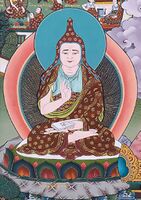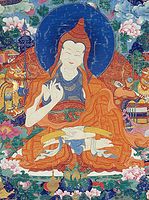Śāntarakṣita: Difference between revisions
No edit summary |
No edit summary |
||
| (3 intermediate revisions by 2 users not shown) | |||
| Line 1: | Line 1: | ||
{{Person | {{Person | ||
|MainNamePhon=Śāntarakṣita | |MainNamePhon=Śāntarakṣita | ||
|MainNameTib= | |MainNameTib=ཞི་བ་འཚོ་ | ||
|MainNameWylie=zhi ba 'tsho | |MainNameWylie=zhi ba 'tsho | ||
|PersonType=Classical Indian Authors | |||
|images=File:Shantarakshita.jpg | |||
File:Shantirakshita Google Art Project Wikipedia.jpg | |||
|YearBirth=725 | |YearBirth=725 | ||
|YearDeath=788 | |YearDeath=788 | ||
|BornIn=Zahor, Bengal | |BornIn=Zahor, Bengal | ||
|BnwShortPersonBio=Eighth-century Indian Mahäyäna master who played an important role in the introduction of Buddhism into Tibet. According to traditional accounts, he was born into a royal family in Zahor in Bengal and was ordained at Nālandā monastery, where he became a renowned scholar. He is best known for two works. The first is the ''Tattvasaṃgraha'', or "Compendium of Principles," a critical survey and analysis of the various non-Buddhist and Buddhist schools of Indian philosophy, set forth in 3,646 verses in twenty-six chapters. This work, which is preserved in Sanskrit, along with its commentary by his disciple Kamalaśīla, remains an important source on the philosophical systems of India during this period. His other famous work is the | |BdrcLink=https://www.tbrc.org/#!rid=P5659 | ||
Madhyamakālaṃkāra, or "Ornament of the Middle Way," which sets forth his own philosophical position, identified by later Tibetan doxographers as Yogācāra-*Svātantrika-Madhyamaka, so called because it asserts, as in Yogācāra, that external objects do not exist, i.e., that sense objects are of the nature of consciousness; however, it also asserts, unlike Yogācāra and like Madhyamaka, that consciousness lacks ultimate existence. It further asserts that conventional truths (''saṃvṛtisatya'') possess their own character (''svalakṣana'') and in this regard differs from the other branch of Madhyamaka, the *Prāsangika. The Yogācāra-Madhyamaka synthesis, of which Śāntarakṣita is the major proponent, was the most important philosophical | |BdrcPnum=5659 | ||
development of late Indian Buddhism, and the ''Madhyamakālaṃkāra'' is its locus classicus. This work, together with the ''Madhyamakāloka'' of Śāntarakṣita's disciple Kamalaśīla and the | |HasDrlPage=Yes | ||
''Satyadvayavibhaṅga'' of Jnānagarbha, are known in Tibet as the "three works of the eastern *Svātantrikas" (''rang rgyud shar gsum'') because the three authors were from Bengal. Śāntarakṣita's renown as a scholar was such that he was invited to Tibet by King Khri srong lde btsan. When a series of natural disasters indicated that the local deities were not positively disposed to the introduction of Buddhism, he left Tibet for Nepal and advised the king to invite the Indian tantric master Padmasambhava, who subdued the local deities. With this accomplished, Śāntarakṣita returned, the first Buddhist monastery of Bsam yas was founded, and Śāntarakṣita invited twelve Mūlasarvāstivāda monks to Tibet to ordain the first seven Tibetan monks. Śāntarakṣita lived and taught at Bsam yas from its founding (c. 775) until his death (c. 788) in an equestrian accident. Tibetans refer to him as the "bodhisattva abbot." The founding of Bsam yas and the ordination of the first monks were pivotal moments in Tibetan Buddhist history, and the relationship of Śāntarakṣita, Padmasambhava, and Khri srong lde btsan figures in many Tibetan legends, most famously as brothers in a previous life. Prior to his death, Śāntarakṣita predicted that a doctrinal dispute would arise in Tibet, in which case his disciple Kamalaśīla should be invited from India. Such a conflict arose between the Indian and Chinese factions, and Kamalaśīla came to Tibet to debate with the Chan monk Moheyan in what is referred to as the Bsam yas Debate, or the "Council of Lhasa." (Source: "Śāntarakṣita." In ''The Princeton Dictionary of Buddhism'', 773. Princeton University Press, 2014) | |HasLibPage=Yes | ||
|HasBnwPage=Yes | |||
|pagename=Śāntarakṣita | |||
|AltNamesWylie=mkhan chen bo d+hi sa twa | |||
|AltNamesTib=མཁན་ཆེན་བོ་དྷི་ས་ཏྭ་ | |||
|BnwShortPersonBio=Eighth-century Indian Mahäyäna master who played an important role in the introduction of Buddhism into Tibet. According to traditional accounts, he was born into a royal family in Zahor in Bengal and was ordained at Nālandā monastery, where he became a renowned scholar. He is best known for two works. The first is the ''Tattvasaṃgraha'', or "Compendium of Principles," a critical survey and analysis of the various non-Buddhist and Buddhist schools of Indian philosophy, set forth in 3,646 verses in twenty-six chapters. This work, which is preserved in Sanskrit, along with its commentary by his disciple Kamalaśīla, remains an important source on the philosophical systems of India during this period. His other famous work is the ''Madhyamakālaṃkāra'', or "Ornament of the Middle Way," which sets forth his own philosophical position, identified by later Tibetan doxographers as Yogācāra-*Svātantrika-Madhyamaka, so called because it asserts, as in Yogācāra, that external objects do not exist, i.e., that sense objects are of the nature of consciousness; however, it also asserts, unlike Yogācāra and like Madhyamaka, that consciousness lacks ultimate existence. It further asserts that conventional truths (''saṃvṛtisatya'') possess their own character (''svalakṣana'') and in this regard differs from the other branch of Madhyamaka, the *Prāsangika. The Yogācāra-Madhyamaka synthesis, of which Śāntarakṣita is the major proponent, was the most important philosophical development of late Indian Buddhism, and the ''Madhyamakālaṃkāra'' is its locus classicus. This work, together with the ''Madhyamakāloka'' of Śāntarakṣita's disciple Kamalaśīla and the ''Satyadvayavibhaṅga'' of Jnānagarbha, are known in Tibet as the "three works of the eastern *Svātantrikas" (''rang rgyud shar gsum'') because the three authors were from Bengal. Śāntarakṣita's renown as a scholar was such that he was invited to Tibet by King Khri srong lde btsan. When a series of natural disasters indicated that the local deities were not positively disposed to the introduction of Buddhism, he left Tibet for Nepal and advised the king to invite the Indian tantric master Padmasambhava, who subdued the local deities. With this accomplished, Śāntarakṣita returned, the first Buddhist monastery of Bsam yas was founded, and Śāntarakṣita invited twelve Mūlasarvāstivāda monks to Tibet to ordain the first seven Tibetan monks. Śāntarakṣita lived and taught at Bsam yas from its founding (c. 775) until his death (c. 788) in an equestrian accident. Tibetans refer to him as the "bodhisattva abbot." The founding of Bsam yas and the ordination of the first monks were pivotal moments in Tibetan Buddhist history, and the relationship of Śāntarakṣita, Padmasambhava, and Khri srong lde btsan figures in many Tibetan legends, most famously as brothers in a previous life. Prior to his death, Śāntarakṣita predicted that a doctrinal dispute would arise in Tibet, in which case his disciple Kamalaśīla should be invited from India. Such a conflict arose between the Indian and Chinese factions, and Kamalaśīla came to Tibet to debate with the Chan monk Moheyan in what is referred to as the Bsam yas Debate, or the "Council of Lhasa." (Source: "Śāntarakṣita." In ''The Princeton Dictionary of Buddhism'', 773. Princeton University Press, 2014) | |||
|IsInGyatsa=No | |IsInGyatsa=No | ||
|classification=Person | |classification=Person | ||
}} | }} | ||
Latest revision as of 14:53, 23 September 2025
| PersonType | Category:Classical Indian Authors |
|---|---|
| MainNamePhon | Śāntarakṣita |
| MainNameTib | ཞི་བ་འཚོ་ |
| MainNameWylie | zhi ba 'tsho |
| AltNamesTib | མཁན་ཆེན་བོ་དྷི་ས་ཏྭ་ |
| AltNamesWylie | mkhan chen bo d+hi sa twa |
| YearBirth | 725 |
| YearDeath | 788 |
| BornIn | Zahor, Bengal |
| BDRC | https://www.tbrc.org/#!rid=P5659 |
| IsInGyatsa | No |
| BnwShortPersonBio | Eighth-century Indian Mahäyäna master who played an important role in the introduction of Buddhism into Tibet. According to traditional accounts, he was born into a royal family in Zahor in Bengal and was ordained at Nālandā monastery, where he became a renowned scholar. He is best known for two works. The first is the Tattvasaṃgraha, or "Compendium of Principles," a critical survey and analysis of the various non-Buddhist and Buddhist schools of Indian philosophy, set forth in 3,646 verses in twenty-six chapters. This work, which is preserved in Sanskrit, along with its commentary by his disciple Kamalaśīla, remains an important source on the philosophical systems of India during this period. His other famous work is the Madhyamakālaṃkāra, or "Ornament of the Middle Way," which sets forth his own philosophical position, identified by later Tibetan doxographers as Yogācāra-*Svātantrika-Madhyamaka, so called because it asserts, as in Yogācāra, that external objects do not exist, i.e., that sense objects are of the nature of consciousness; however, it also asserts, unlike Yogācāra and like Madhyamaka, that consciousness lacks ultimate existence. It further asserts that conventional truths (saṃvṛtisatya) possess their own character (svalakṣana) and in this regard differs from the other branch of Madhyamaka, the *Prāsangika. The Yogācāra-Madhyamaka synthesis, of which Śāntarakṣita is the major proponent, was the most important philosophical development of late Indian Buddhism, and the Madhyamakālaṃkāra is its locus classicus. This work, together with the Madhyamakāloka of Śāntarakṣita's disciple Kamalaśīla and the Satyadvayavibhaṅga of Jnānagarbha, are known in Tibet as the "three works of the eastern *Svātantrikas" (rang rgyud shar gsum) because the three authors were from Bengal. Śāntarakṣita's renown as a scholar was such that he was invited to Tibet by King Khri srong lde btsan. When a series of natural disasters indicated that the local deities were not positively disposed to the introduction of Buddhism, he left Tibet for Nepal and advised the king to invite the Indian tantric master Padmasambhava, who subdued the local deities. With this accomplished, Śāntarakṣita returned, the first Buddhist monastery of Bsam yas was founded, and Śāntarakṣita invited twelve Mūlasarvāstivāda monks to Tibet to ordain the first seven Tibetan monks. Śāntarakṣita lived and taught at Bsam yas from its founding (c. 775) until his death (c. 788) in an equestrian accident. Tibetans refer to him as the "bodhisattva abbot." The founding of Bsam yas and the ordination of the first monks were pivotal moments in Tibetan Buddhist history, and the relationship of Śāntarakṣita, Padmasambhava, and Khri srong lde btsan figures in many Tibetan legends, most famously as brothers in a previous life. Prior to his death, Śāntarakṣita predicted that a doctrinal dispute would arise in Tibet, in which case his disciple Kamalaśīla should be invited from India. Such a conflict arose between the Indian and Chinese factions, and Kamalaśīla came to Tibet to debate with the Chan monk Moheyan in what is referred to as the Bsam yas Debate, or the "Council of Lhasa." (Source: "Śāntarakṣita." In The Princeton Dictionary of Buddhism, 773. Princeton University Press, 2014) |
| Other wikis |
If the page does not yet exist on the remote wiki, you can paste the tag |


